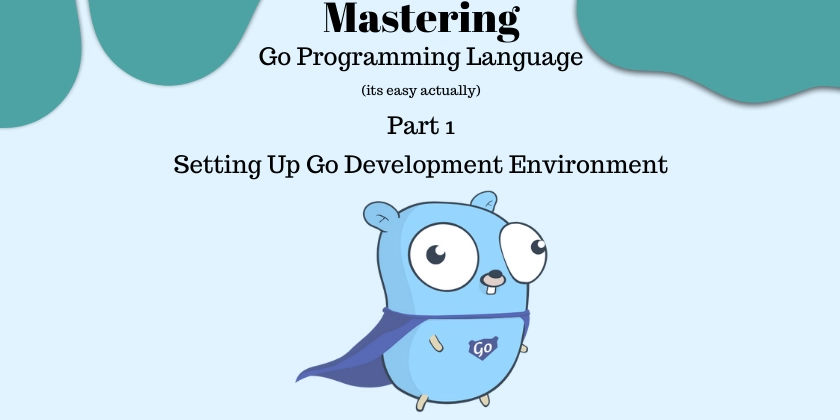Mastering Go is Easy Actually, part 1 : Setting up Go Development Environment
Setting Up Your Go Development Environment: A Comprehensive Guide Every programming language requires a proper development environment, and Go is no exception. Whether you're a seasoned Go developer or just starting out, setting up your environment correctly is crucial for a smooth coding experience. In this guide, we'll walk you through installing Go, writing your first program, and exploring essential tools that make Go development efficient and enjoyable. Installing the Go Tools The first step is to download and install the Go development tools. Visit the official Go downloads page and select the appropriate installer for your operating system: Mac users: Use the .pkg installer or install via Homebrew with brew install go Windows users: Use the .msi installer or install via Chocolatey with choco install golang Linux/BSD users: Download the gzipped TAR file and install manually: $ tar -C /usr/local -xzf go1.20.5.linux-amd64.tar.gz $ echo 'export PATH=$PATH:/usr/local/go/bin' >> $HOME/.bash_profile $ source $HOME/.bash_profile Verify your installation by running: $ go version You should see output similar to go version go1.20.5 darwin/arm64 (Mac) or go version go1.20.5 linux/amd64 (Linux). Your First Go Program Let's create the classic "Hello, World!" program to test your setup: Create a new directory for your project: $ mkdir ch1 $ cd ch1 Initialize a Go module: $ go mod init hello_world Create a file named hello.go with the following content: package main import "fmt" func main() { fmt.Println("Hello, world!") } Build and run your program: $ go build $ ./hello_world Hello, world! Essential Go Tools Go comes with powerful built-in tools that help maintain code quality: go fmt The go fmt command automatically formats your code to match Go's standard style: $ go fmt ./... go vet go vet detects potential bugs in your code that might compile but could cause issues: $ go vet ./... go run For quick testing without building an executable: $ go run hello.go Choosing Development Tools While you can write Go code with any text editor, these IDEs offer excellent Go support: Visual Studio Code Free and open-source Install the Go extension for full support Features: auto-formatting, code completion, debugging GoLand Commercial IDE from JetBrains Comprehensive Go support out of the box Free trial available The Go Playground For quick experimentation without local setup: Access The Go Playground Write and run small Go programs Share code via unique URLs Automating with Makefiles Create a Makefile to automate common tasks: .DEFAULT_GOAL := build .PHONY: fmt vet build fmt: go fmt ./... vet: fmt go vet ./... build: vet go build Run with: $ make Staying Up-to-Date Go maintains strong backward compatibility. To update: Mac/Windows: Re-run installer or package manager Linux/BSD: $ mv /usr/local/go /usr/local/old-go $ tar -C /usr/local -xzf go1.20.6.linux-amd64.tar.gz $ rm -rf /usr/local/old-go Exercises Run "Hello, World!" on The Go Playground and share the link Add a clean target to your Makefile Experiment with formatting and see how go fmt responds Conclusion You now have a fully functional Go development environment! With these tools in place, you're ready to explore Go's features and start building robust applications. In the next chapter, we'll dive into Go's type system and variable declarations.

Setting Up Your Go Development Environment: A Comprehensive Guide
Every programming language requires a proper development environment, and Go is no exception. Whether you're a seasoned Go developer or just starting out, setting up your environment correctly is crucial for a smooth coding experience. In this guide, we'll walk you through installing Go, writing your first program, and exploring essential tools that make Go development efficient and enjoyable.
Installing the Go Tools
The first step is to download and install the Go development tools. Visit the official Go downloads page and select the appropriate installer for your operating system:
-
Mac users: Use the
.pkginstaller or install via Homebrew withbrew install go -
Windows users: Use the
.msiinstaller or install via Chocolatey withchoco install golang - Linux/BSD users: Download the gzipped TAR file and install manually:
$ tar -C /usr/local -xzf go1.20.5.linux-amd64.tar.gz
$ echo 'export PATH=$PATH:/usr/local/go/bin' >> $HOME/.bash_profile
$ source $HOME/.bash_profile
Verify your installation by running:
$ go version
You should see output similar to go version go1.20.5 darwin/arm64 (Mac) or go version go1.20.5 linux/amd64 (Linux).
Your First Go Program
Let's create the classic "Hello, World!" program to test your setup:
- Create a new directory for your project:
$ mkdir ch1
$ cd ch1
- Initialize a Go module:
$ go mod init hello_world
- Create a file named
hello.gowith the following content:
package main
import "fmt"
func main() {
fmt.Println("Hello, world!")
}
- Build and run your program:
$ go build
$ ./hello_world
Hello, world!
Essential Go Tools
Go comes with powerful built-in tools that help maintain code quality:
go fmt
The go fmt command automatically formats your code to match Go's standard style:
$ go fmt ./...
go vet
go vet detects potential bugs in your code that might compile but could cause issues:
$ go vet ./...
go run
For quick testing without building an executable:
$ go run hello.go
Choosing Development Tools
While you can write Go code with any text editor, these IDEs offer excellent Go support:
Visual Studio Code
- Free and open-source
- Install the Go extension for full support
- Features: auto-formatting, code completion, debugging
GoLand
- Commercial IDE from JetBrains
- Comprehensive Go support out of the box
- Free trial available
The Go Playground
For quick experimentation without local setup:
- Access The Go Playground
- Write and run small Go programs
- Share code via unique URLs
Automating with Makefiles
Create a Makefile to automate common tasks:
.DEFAULT_GOAL := build
.PHONY: fmt vet build
fmt:
go fmt ./...
vet: fmt
go vet ./...
build: vet
go build
Run with:
$ make
Staying Up-to-Date
Go maintains strong backward compatibility. To update:
- Mac/Windows: Re-run installer or package manager
- Linux/BSD:
$ mv /usr/local/go /usr/local/old-go
$ tar -C /usr/local -xzf go1.20.6.linux-amd64.tar.gz
$ rm -rf /usr/local/old-go
Exercises
- Run "Hello, World!" on The Go Playground and share the link
- Add a
cleantarget to your Makefile - Experiment with formatting and see how
go fmtresponds
Conclusion
You now have a fully functional Go development environment! With these tools in place, you're ready to explore Go's features and start building robust applications. In the next chapter, we'll dive into Go's type system and variable declarations.






































































